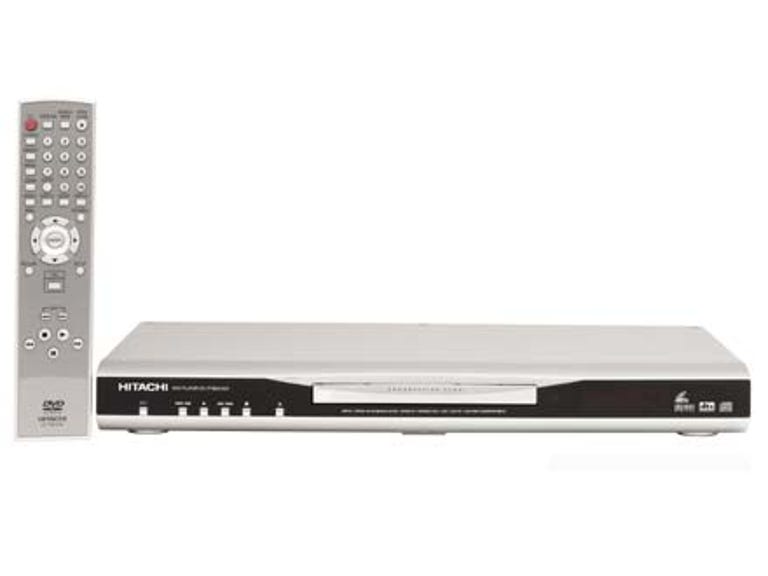 Why You Can Trust CNET
Why You Can Trust CNET Hitachi DV-RX7000A review: Hitachi DV-RX7000A
Up against the current crop of recorders, even in the entry level space, it ends up just being an average player.
The DV-RX7000A employs a relatively unobtrusive front design, with very minimalist buttons and a central tray and LED display. A drop down panel reveals a set of front AV ports, while at the back you'll find all the other ports the DV-RX7000A supports. Physically it's an average sized player at 430 x 272 x 69mm and 3.7kg. The same minimalist design ethic carries through to the bundled remote, which is solidly large and initially a bit intimidating. Of particular note, however, is that somebody at Hitachi must have a sense of humour, as the remote features a button labelled as 'Any Key". Aside from the regular controls you'd expect on a normal DVD player, the recording functions are plunked at the bottom of the remote. If you're an incurable button twiddler, this can be a bit dangerous, as we discovered by accidentally recording some daytime TV in the middle of testing.
Features
The DV-RX7000A sits in the DVD minus camp, meaning it's a player that will record to DVD-R, DVD-RW and DVD-RAM only, in a very familiar fashion to players like the Panasonic DMR-E55. That's a particularly apt player to compare the DV-RX7000A to, actually, as the feature set between the two is essentially identical -- but the DMR-E55 will set you back around AU$150 less than the DV-RX7000A.
The Good
The Bad
The Bottom Line
With DVD-RAM support you do get the benefits of many thousands of rewrite cycles, along with a potential for twelve hours of recording time, if you're using double sided 9.4GB DVD-RAM discs. On more standard (and much more easily obtained) DVD-R/RW media, you can select from four recording quality modes. At its highest setting, XP, you'll get the standard 1 hour to a single sided disc, while SP, LP and EP will give you two, four and six hours respectively, albeit with a solid loss of quality as you increase the recording time.
The DV-RX7000A will allow you to perform chase play -- that's replaying earlier sections of a recording while continuing to record "live" TV. Of note if you're a user with a Hitachi DVD Camera is the manufacturer's claim that it'll read from 8cm DVD-R discs, even unfinalised ones, which could make it a useful companion tool for some quick and dirty video editing on the fly. Lacking in a suitable Hitachi DVD camera, we were unable to test this functionality, however.
Performance
In direct recording terms, we hit a few minor niggles that make the DV-RX7000A a touch annoying to use, and that's not a good thing in a market this busy, especially at the cheaper end of town. Disc reading was fine across all media, but in almost every one of our tests, the DV-RX7000A tended to read and then play back discs a lot slower than in comparative recorders, meaning that when it comes time to review your completed recordings (or even commercial DVDs) you'll have a slightly longer than normal wait before you're chewing popcorn and merrily laughing along.
On the recording front, we found it equally irksome that when you switch between recording modes, it gives you no onscreen indication of how much time each mode will give you. Given that players like the LG DR4812W -- an extremely long in the tooth player -- will even tell you how much space you've got left on the disc when flipping recording modes, this is more than a minor annoyance.
As with every other player on the market, once you get above the two hour recording limit you'll start to notice some pretty awful onscreen compression artefacts, especially with any kind of live action programming. It can be handy, however, to be able to record six hours of children's cartoons onto a single disc -- especially for longer car drives if you've got a portable DVD player such as the Sony MV-65ST DVD Station -- as animation artefacts are harder to spot on heavily compressed discs. On the subject of playback, while officially the DV-RX7000A is set as region four, the model we tested with had no problems with discs from other regions.
The lower end of DVD recording is being squeezed particularly hard by the dropping prices of hard disc-based recorders, and there were bound to be some casualties along the way. With an asking price of AU$799, the DV-RX7000A would have been an excellent recording option twelve months ago. However, with hard disc models fast racing under the AU$1000 price limit, it's a lot to ask for a player with this feature set, especially against competition like the Panasonic DMR-E55 or LG DR4812W.


